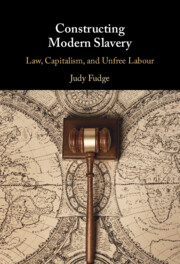Refine search
Actions for selected content:
58 results
2 - Inter-Asia’s Company Towns
- from Part I - Commercial Law
-
-
- Book:
- Inter-Asian Law
- Published online:
- 16 December 2025
- Print publication:
- 22 January 2026, pp 40-56
-
- Chapter
-
- You have access
- Open access
- HTML
- Export citation
Stakeholder opinions of seaweed supplements for dairy cows
-
- Journal:
- Renewable Agriculture and Food Systems / Volume 40 / 2025
- Published online by Cambridge University Press:
- 03 November 2025, e23
-
- Article
-
- You have access
- Open access
- HTML
- Export citation
8 - Graph Theory, Combinatorial Optimization, and Supply Chains
-
- Book:
- Insight-Driven Problem Solving
- Published online:
- 21 October 2025
- Print publication:
- 30 October 2025, pp 250-278
-
- Chapter
- Export citation
Voter perceptions and the politics of hidden costs in unilateral sustainable supply chain regulations
-
- Journal:
- European Journal of Political Research ,
- Published online by Cambridge University Press:
- 01 October 2025, pp. 1-16
-
- Article
-
- You have access
- Open access
- HTML
- Export citation
15 - US-China Relations and the Competitive Turn of Green Industrial Policymaking
- from Part IV - Global Politics
-
-
- Book:
- Stability and Politicization in Climate Governance
- Published online:
- 07 August 2025
- Print publication:
- 21 August 2025, pp 222-236
-
- Chapter
-
- You have access
- Open access
- HTML
- Export citation
Supplying Influence: Domestic Production Networks in Trade Politics
-
- Journal:
- International Organization / Volume 79 / Issue 3 / Summer 2025
- Published online by Cambridge University Press:
- 19 August 2025, pp. 456-493
- Print publication:
- Summer 2025
-
- Article
-
- You have access
- Open access
- HTML
- Export citation
Critical minerals policies need clearer interface with scientifically credible targets
-
- Journal:
- Global Sustainability / Volume 8 / 2025
- Published online by Cambridge University Press:
- 14 July 2025, e25
-
- Article
-
- You have access
- Open access
- HTML
- Export citation
The Normative Core of Relational Stakeholder Strategies: Explaining Open Buyer-Supplier Relations in the Context of the Amazon Rainforest
-
- Journal:
- Business Ethics Quarterly , First View
- Published online by Cambridge University Press:
- 13 May 2025, pp. 1-43
-
- Article
-
- You have access
- Open access
- HTML
- Export citation
A roadmap for modeling institutional and values-based procurement decisions in food supply chains
-
- Journal:
- Agricultural and Resource Economics Review / Volume 54 / Issue 1 / April 2025
- Published online by Cambridge University Press:
- 03 April 2025, pp. 109-137
-
- Article
-
- You have access
- Open access
- HTML
- Export citation
Demystifying China's Critical Minerals Strategies: Rethinking ‘De-risking’ Supply Chains
-
- Journal:
- World Trade Review / Volume 24 / Issue 2 / May 2025
- Published online by Cambridge University Press:
- 30 January 2025, pp. 257-281
- Print publication:
- May 2025
-
- Article
- Export citation
Introduction
-
- Book:
- Constructing Modern Slavery
- Published online:
- 09 January 2025
- Print publication:
- 23 January 2025, pp 1-12
-
- Chapter
-
- You have access
- Open access
- HTML
- Export citation
3 - The ILO’s Governance of Forced Labour
-
- Book:
- Constructing Modern Slavery
- Published online:
- 09 January 2025
- Print publication:
- 23 January 2025, pp 65-98
-
- Chapter
-
- You have access
- Open access
- HTML
- Export citation
2 - Philanthrocapitalism’s Market-Friendly Solution
-
- Book:
- Constructing Modern Slavery
- Published online:
- 09 January 2025
- Print publication:
- 23 January 2025, pp 41-64
-
- Chapter
-
- You have access
- Open access
- HTML
- Export citation
6 - Global Britain and the Modern Slavery Act 2015
-
- Book:
- Constructing Modern Slavery
- Published online:
- 09 January 2025
- Print publication:
- 23 January 2025, pp 164-202
-
- Chapter
-
- You have access
- Open access
- HTML
- Export citation

Constructing Modern Slavery
- Law, Capitalism, and Unfree Labour
-
- Published online:
- 09 January 2025
- Print publication:
- 23 January 2025
-
- Book
-
- You have access
- Open access
- Export citation
6 - East Asian Growth
- from Part III - East Asia since 1945
-
- Book:
- East Asian International Relations
- Published online:
- 28 November 2024
- Print publication:
- 19 December 2024, pp 157-189
-
- Chapter
- Export citation
Human Rights Due Diligence for Arms Companies: Lessons from Supply Chain Regulations
-
- Journal:
- European Journal of Risk Regulation / Volume 16 / Issue 2 / June 2025
- Published online by Cambridge University Press:
- 15 November 2024, pp. 704-720
-
- Article
-
- You have access
- Open access
- HTML
- Export citation
Nowhere else in the world? The Korean Safe Rates System in global context
-
- Journal:
- The Economic and Labour Relations Review / Volume 35 / Issue 3 / September 2024
- Published online by Cambridge University Press:
- 11 November 2024, pp. 649-663
-
- Article
- Export citation
6 - Even in the Quietest Moments: Amplifying the Electric Guitar
- from Part II - Technology and Timbre
-
-
- Book:
- The Cambridge Companion to the Electric Guitar
- Published online:
- 08 November 2024
- Print publication:
- 17 October 2024, pp 93-110
-
- Chapter
- Export citation
7 - Economic Tradecraft and Commercial Diplomacy
-
-
- Book:
- Diplomatic Tradecraft
- Published online:
- 15 March 2024
- Print publication:
- 28 March 2024, pp 150-173
-
- Chapter
- Export citation
